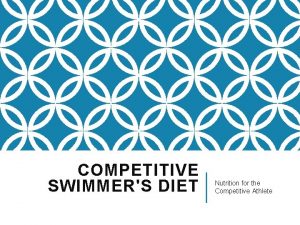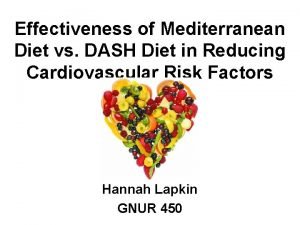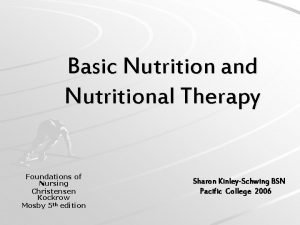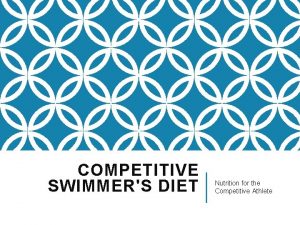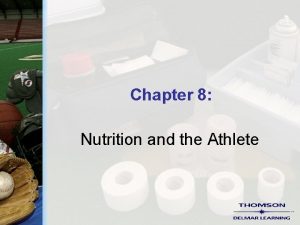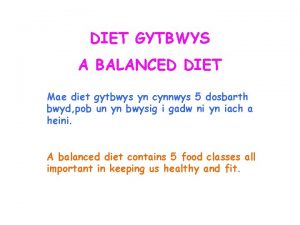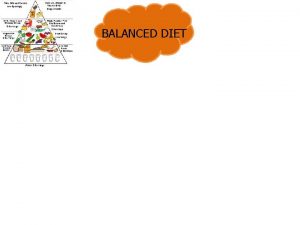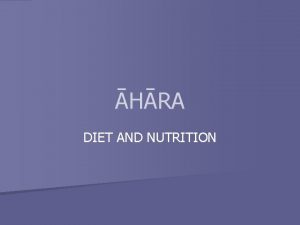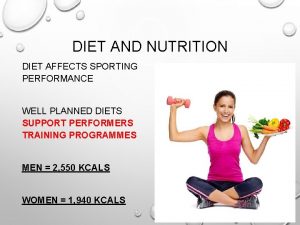COMPETITIVE SWIMMERS DIET Nutrition for the Competitive Athlete















- Slides: 15

COMPETITIVE SWIMMER'S DIET Nutrition for the Competitive Athlete

FUEL: KEROSENE OR HIGH For competitive OCTANE? swimmers, performance and speed are very important. In fact, fuel is just as important as the training schedule. Competitive athletics, such as swimming, may expend thousands of calories depending upon gender, weight and training schedule. The caloric breakdown for a competitive swimmer's diet should be about 60 to 70 percent of calories from carbohydrates, 20 to 25 percent from protein and 15 to 20 percent from fat.

DIET BASICS According to the World's Healthiest Foods website, competitive athletes, such as swimmers, need more calories than recreational athletes. On average, female swimmers may need 4, 000 calories daily, while males may require 6, 000 calories daily or more. Ideally, their diets should be high in carbohydrates, provide an adequate amount of protein for building and maintaining muscles and be low in fat.

CARBOHYDRATES Carbohydrates should be the foundation of a competitive swimmer's diet, although carbohydrate "loading" is usually unnecessary, according to Fitness. gov. The amount of carbohydrates, in grams, varies according to calorie level. For example, a swimmer on a 5, 000 -calorie diet may need nearly 800 grams daily, which is about 65 percent of total calories from carbohydrates. Food sources of carbohydrates include simple sugars, such as fructose, the form of sugar found in juices and fruits; milk sugar, or lactose, found in dairy products; sucrose or table sugar; as well as complex carbohydrate foods, such as whole grains and starchy vegetables. All sugars, such as fructose and sucrose, are digested and converted to glucose by the liver.

PROTEIN The building blocks of proteins are amino acids. Amino acids are broken down for energy for muscles when glycogen stores get too low during exercise. At this time the body breaks down a bit of muscle as well as some fat. Thus protein is necessary for rebuilding tissues. According to the ESPN website, the daily protein requirement for a competitive athlete, such as a swimmer, is 1. 2 to 1. 4 g per kilogram of body weight. Good protein food sources include whey powder, chicken, meat and fish, eggs, soy products, milk and other dairy products.

FLUIDS Competitive swimmers should consume plenty of fluids, particularly water or electrolyte-enhanced beverages. According to Dena Mc. Dowell, M. S. R. D. , "Along with a proper diet and training, hydration provides an edge to becoming a winning athlete. " Glucose and electrolyte-enhanced beverages replenish glycogen stores in the muscles and liver and provide much-needed hydration. Athletes should begin a competition hydrated and drink chilled liquids frequently throughout an event as they are absorbed faster than roomtemperature fluids and help to lower body temperature. The atmosphere in most swimming pools is very hot and humid and these conditions can lead very easily to dehydration. So a swimmer is losing fluid/water all the time and must replace it. Being dehydrated affects coordination, concentration and reduces the length of time a swimmer can keep swimming at high speed.

PRE- AND POSTCOMPETITION MEALS Pre-competition meal recommendations are similar for all athletes, regardless of age, gender or sport. A pre-competition meal should be eaten three to four hours before the event and consist of mostly carbohydrate-rich foods. This meal may provide 500 to 1, 000 calories. Thirty minutes following the competition is the best time to replenish depleted glycogen stores by eating a smaller meal, composed of some carbohydrates, proteins and fats.

PRE- AND POSTTRAINING SNACKS A good recovery snack provides carbohydrate to replenish muscle glycogen and a small amount of protein to aid in repairing and strengthening muscles. Recovery nutrition is most important for swimmers who train daily or compete in several events over the course of a day(s) during a meet. Just as important to the swimmer is nutrition immediately after a training session. This recovery snack should be consumed within 30 minutes of the end of practice. Also, a swimmer coming to practice immediately after school may not have eaten for several hours and should have something to eat between the end of school and the beginning of practice.

HOW TO GET YOUNG SWIMMERS TO EAT WELL Knowing what to feed a swimmer is challenging enough, but even when all the nutrition ducks are in a row, getting a swimmer to make the right food choices is a whole different battle. So how can swimmers be encouraged to eat well?

SET UP A HEALTHY FOOD ENVIRONMENT: Parents are the “nutritional gatekeepers. ” That is, they control the majority of food that gets purchased, stocked and prepared in the home. They also control how frequently the family eats together, dines out, visits fast food joints, and the purse strings (the money). As swimmers age, parents have less control over these factors, which is why it’s important to establish a nutritious food environment early on. If healthy foods are available at home, the swimmer will be more likely to eat them.

ENCOURAGE FUELING: Swimmers who want to perform their best need to have nutrition on board. It makes a difference! Swimming on an empty stomach, a tummy full of sugar or fried foods, or an overly full stomach will impact pace, comfort level and endurance. Find the right amount and type of food to best suit the body, whether a banana on the morning of competition, or a bagel with peanut butter.

TAP INTO DEVELOPMENTAL STAGE: Each developmental milestone is different. For example, during the school-age years, kids are interested in learning new skills. Teaching them how to cook and the basics of nutrition is not only developmentally appropriate, it allows a natural way to explore food and learn. During the teen years, the mind is more capable of understanding complex nutrition topics, like how the body uses food during exercise, and explaining these topics will help to build ownership and responsibility with caring for nutritional needs. Remember, though, teens are also risk-takers and love to experiment with new things (even unproductive dieting!), so keep the conversation about healthy nutrition going

SET THE RULES: During competition weekends, set a “no junk food” policy (no candy, no chips, etc. ). This can be a team or family rule and sets the tone and manner of competition. Consider a training diet rule as well, such as “indulgences on the weekends only. ”

STICK WITH A PLAN: Eating tends to fall apart when there is no plan. When swimmers come to a meet without any snacks, they go to the concession stand. When they don’t have water, they go to the vending machine. When pre-competition meals aren’t planned, swimmers may not get a good balance of everything they need. While it may seem hard to get a plan going, the reality is a plan makes everything easier.

 Competitive swimmers diet plan
Competitive swimmers diet plan Swimmers unit 3 letters
Swimmers unit 3 letters The water beckoned invitingly to the hot swimmers meaning
The water beckoned invitingly to the hot swimmers meaning Dash vs mediterranean diet
Dash vs mediterranean diet Chapter 11 nutrition and diets
Chapter 11 nutrition and diets Nutrition and diet therapy nursing
Nutrition and diet therapy nursing Chapter 11 nutrition and diets key terms
Chapter 11 nutrition and diets key terms Competitive antagonist
Competitive antagonist Chapter 5 competitive rivalry and competitive dynamics
Chapter 5 competitive rivalry and competitive dynamics Least competitive market
Least competitive market Head bumps ball reaction
Head bumps ball reaction Olympic background images
Olympic background images Physics javelin projectile motion
Physics javelin projectile motion Pulse rate group
Pulse rate group Envy suffix
Envy suffix Loop en val athlete
Loop en val athlete
